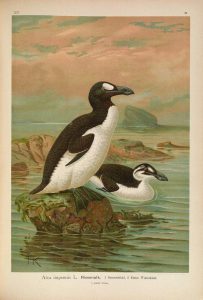The story of the last Passenger Pigeon and the disappearance of the Great Auk, Carolina Parakeet, and Heath Hen reveal the fragile connections between species and their environment. To help tell their story, the Smithsonian Libraries, Biodiversity Heritage Library, and the National Museum of Natural History have curated a joint exhibit entitled Once There Were Billions: Vanished Birds of North America which opened June 24 in the National Museum of Natural History. Over the next several weeks, we’ll be highlighting each of the four birds with content from the exhibition and illustrations from BHL.
The Great Auk (Pinguinus impennis) once lived in large, dense colonies along North Atlantic shores. Clumsy and flightless on land, they were perfectly adapted to “fly” underwater, with their small wings and streamlined bodies.
Unfortunately, they could not flee human predators. Hunters slaughtered Auks by the thousands for meat, eggs, feathers, and oil. Once the bird’s numbers dwindled precipitously, naturalists hurried to add them as specimens to their collections before they disappeared forever. By the mid-1800s the species went extinct—the final result of centuries of intense human exploitation.

What can be done to prevent future extinctions? One way is to support researchers who seek a better understanding of the biodiversity of this planet.
The Biodiversity Heritage Library (BHL) is a global project that is changing the way research is done, by digitizing and sharing biodiversity literature online. BHL makes more than 43 million pages and nearly 100,000 scientific illustrations—of animals and plants, living and extinct—freely available to scientists and other users around the world.
The Great Auk is documented in over 3,000 pages of the literature found in of the BHL corpus. BHL relies on donations from individuals to support scanning of the biodiversity literature held in some of the world’s most renowned natural history and botanical libraries. To learn more about how your donation supports the continued growth of BHL, please visit this page. We hope you’ll consider making a contribution today!

Be First to Comment